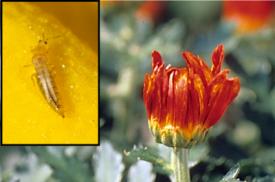

Eastern flower thrips damage on mum. (Photo: Phil Nixon)
|
|
| Severity: | 1-3 out of 5 |
| Frequency: | 2-4 out of 5 |
| Symptoms: | Symptoms: Plant injury is the result of rasping of the surface of leaves, stems, buds, and flowers. The result is usually white to silvery necrotic lines and often dieback. |
| Cycle: | Several thousand species of thrips have been identified.Thrips (thrips is also the singular) range in size from 0.5 to 14mm but most are about 1 to 3 mm long. They have a cone shaped rasping-sucking mouth and their wings are lined with long hairs. One group of thrips have an ovipositor and lay their eggs in plant tissue. The other group of thrips, have no ovipositor and lay the eggs on the plant surface. Thrips tend to have several generations per growing season. Thrips feed on a wide range of flowers. Following are a few of the thrips that feed on and cause damage on horticulture type plants: Flower thrips host plants include chrysanthemums, daisies, daylilies, irises, peonies, roses, and strawberries. Daylily thrips host plants are daylillies. Gladiolus thrips host plants include amaryllises, chrysanthemums, gladioluses, hollyhocks, irises, lilies, narcissuses, and primulas. Greenhouse thrips host plants include azaleas, palms, orchids, avocadoes, philodendrons, ferns, and hibicuses. Banded greenhouse thrip host plants include African violets, chrysanthemums, figs, gardenias, jasmines, tomatoes, dieffenbachias, hoyas, philodendrons, rubber trees, and scheffleras. Grass thrips host plants include turfgrasses. Cuban laurel thrips host plants include Ficus nitida and Ficus benjamani. Onion thrips host plants include onions, cabbages and beans. Pear thrip host plants are pears. Privet thrips host plants are privets. Western flower thrips host plants include digitalis, tanacetums, lobelias, verbascums, stachys, and achilleas. Other thrips will attach the following host plants - annual asters, dahlias, gladioluses, lilies, tuberous begonias and wax begonias.
|
| Management: | Non-chemical management includes encouraging predators by avoiding unnecessary use of insecticides and dead heading dead flowers. There are several "organic" and inorganic insecticides that help manage thrips. |
| Associated shrubs: | |